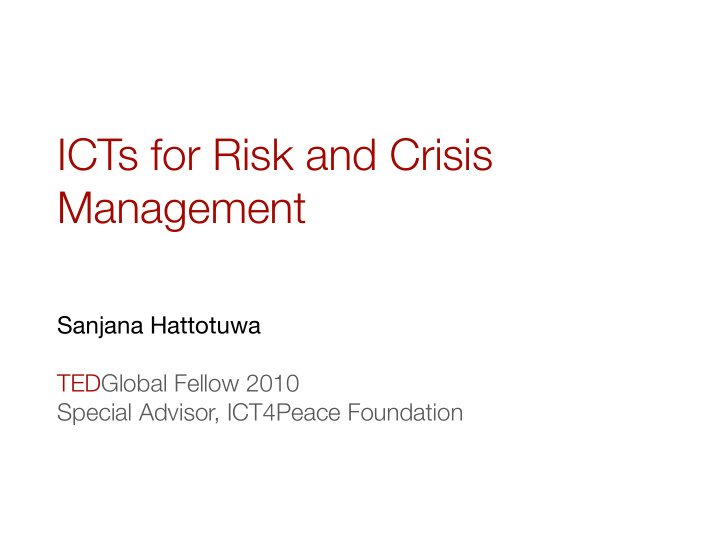



ICTs for Risk and Crisis Management Sanjana Hattotuwa TEDGlobal Fellow 2010 Special Advisor, ICT4Peace Foundation
Three aphorisms "Where is the wisdom we have lost in knowledge?” T.S. • Eliot, 1934 Continuous partial attention, Linda Stone, Microsoft, 1997. • With continuous partial attention we keep the top level item in focus and scan the periphery in case something more important emerges. • The immediate altruistic response rapidly diminishes over time, Melissa Brown, associate director of research at the Center on Philanthropy at Indiana University, 2010. Our brains release congratulatory hits of dopamine when we engage in selfless behaviour — which we’re moved to do the instant we witness something awful.
Dopamine effect and attendant problems • Fundamentally, the simplistic projection of post- earthquake ICT use in Haiti as the future of humanitarian aid (the “turning point” argument) • Little or no appreciation of geo-politics, big-power strategic interests, sovereignty, the nature of government, culture and language, intra-state conflict • Limited attention span and competing interests of international community, selective attention of donors and media, transitory nature of volunteers
Continuous partial attention and its problems • The ICT4Peace wiki on Haiti had over 142 sources. Most of these sources in turn pointed to hundreds of other records. • Ushahidi, Sahana, InSTEDD and UN OneResponse platforms each had thousands of records. Each platform had a slightly different focus, audience and information generation model. There was no single overview. • This multiplicity leads to exponential increase content, with less control and clarity on veracity, duplication, partiality and actionable information.
Good progress: Nargis to Haiti Based, inter alia , on UN Reliefweb media monitoring, from 4 to 25 May 2008 • (Nargis) and 12 January to February 2010 (Haiti earthquake) – Greater emphasis on ICTs and information provisioning as part of relief efforts on the ground. – Greater emphasis on collaboration and coordination between UN, NGOs, government and military – For Haiti, the global scale of volunteerism was far greater and more diverse than Nargis. – Many more CiM providers for Haiti, rapid deployment . Nargis only had UN OCHA’s HIC platform. – Mobiles and web visualisation central to Haiti response. Telecoms didn’t come into play post-Nargis.
Enduring processual challenges • Head of UN OCHA, Sir John Holmes in February 2010 said, – “only a few clusters have fully dedicated cluster coordinators, information-management focal points and technical support capacity” and adding that the disjointed effort is casting doubts on the UN’s ability to effectively provide relief. • Beyond the UN, significant concerns were raised over the coordination and collaboration between civil and military actors, and the international community as a whole.
Enduring technical challenges Inadequate sense making : systems are islands of • information, leading to unnecessary duplication, fragmentation and significant frustration Proprietary data formats : which leads to information lock-in • and data scatter Accountability : plethora of actors leads to multiple decision • making points, with no clear crumbtrails Coordination : lack of information sharing mandates, despite • available ICT platforms
Enduring ethical challenges • Disaster-affected communities remain largely passive recipients of information. Where is the resilient, sustainable tech that gives THEM voice? • Using disasters to field test new ICTs, services and platforms is to use victims as lab rats. Mercenary, marketing and other parochial considerations trump sensitivity to trauma. • It is often unplanned as to how ICTs deployed soon after a disaster will be sustained over the long term. Cost, culture, leave behind & sustainability considerations.
Outrageously overdue • The development and up-to-date population of easily accessible datasets with essential information shared across UN and other aid agencies, to help prepare for, mitigate and recover from disasters. • Significantly improved interoperability .
Progress would be ICTs more resilient to austere, traumatic environments - both a • design and technical issue. Endogenous technologies, helping communities develop their own • capacities and capabilities for disaster early warning, prevention and resilience. Acknowledging role of local business in DRR and post-disaster • recovery. A comprehensive crisis information management preparedness and • assessment tool box, including appraisal mechanisms.
Why reinvent the wheel? Business engagement in humanitarian relief: key trends and policy • implications , Humanitarian Policy Group, http://www.odi.org.uk/hpg/ papers/hpgbgpaper_monitoringtrends1.pdf Recommendations of Strong Angel III: Lessons learnt , • www.strongangel3.net/files/SAIII_working_report_20061106.pdf Global Symposium +5: Information for Humanitarian Action, Geneva, • 22-26 October 2007, Final Statement , http://www.reliefweb.int/ symposium/docs/Symposium%20Final%20Statement.pdf Interim Report: Stocktaking of UN Crisis Information Management • Capabilities , ICT4Peace Foundation, http://www.ict4peace.org/ view_files-1-v-165.html
Thank you www.ict4peace.org
Recommend
More recommend